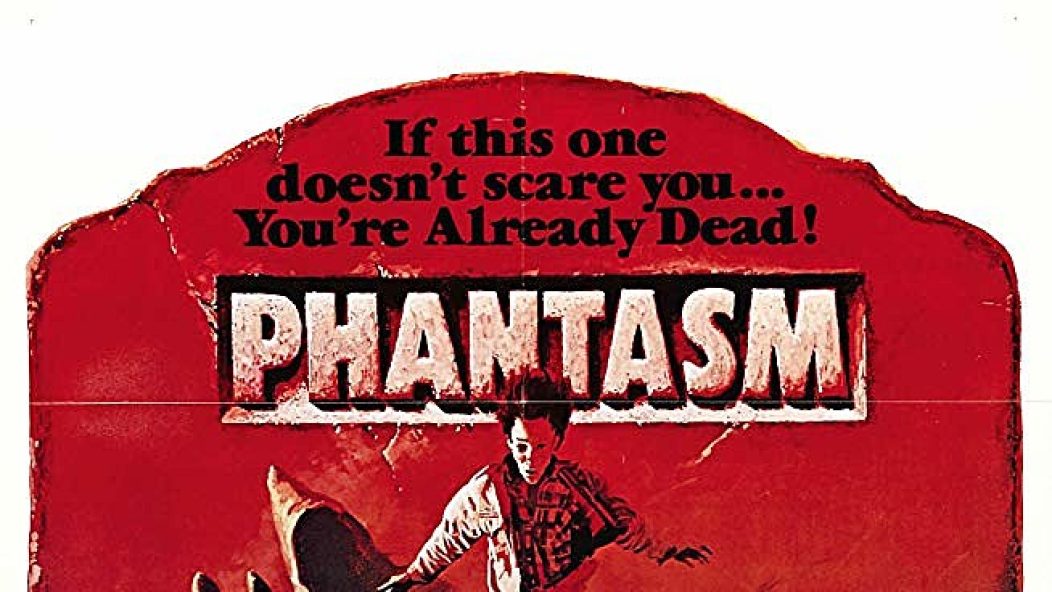
Heavy Metal Movie Madness #2: DIY Death, Featuring Don Coscarelli's “Phantasm”

…
The objective of this column is to highlight movies of the past and present while arguing their importance in understanding many of the heavy metal works we adore. This importance can range from direct references to more subtle cues like the themes and narratives to which bands have attached themselves. I’ve found many extreme music fans to be movie geeks as well, but that’s not always the case, which is fine too. But even the most diehard cinephiles have gaps in their celluloid experiences: this series aims to open doors for readers of all types and perhaps convince some to engage with movies they’ve never seen with metal albums they hold close and dear.
— Joseph Aprill
…
Dreams are curious phenomena. They can amount to powerful experience, tapping into desires and fears often avoided by our conscious, waking minds; simultaneously, they can be a fleeting experience like holding smoke in your hand. After arising from slumber, our dreams and nightmares can astound or shock us, but within minutes the details become murky and obscured until we perhaps remember nothing but lingering emotions. And some of the most bizarre dreams are those dealing with death. It’s often noted by many people how one will wake up right when death seems most imminent in the dream world. Dreams are a relatively safe realm, physically but not necessarily emotionally, to explore our thoughts and feelings about death. Likewise, art is a place related to dreams in how it also functions as a space to explore death with little fear of experiencing its final cold kiss. Following that, few forms of art better explore death than metal and horror movies.
As discussed in the previous entry in this series on the relationship between metal and cinema, the horror genre has a particularly strong relationship to metal music; a key reason for that is the mutual fascination with death. The evidence is plainly obvious in both arts, as it’s near impossible to find a horror movie without someone dying — or at least the fear of death present — while in metal music one needs only point to the fact that a prominent subgenre is literally called death metal. Exploring the hows and whys behind our fear of death is a deep subject, but certainly one aspect is it’s a fear of change. One of the most painful stings death delivers to the living is the finality in ending our relationships to those we love, especially our friends and family — the living are left with little choice but to react to such dramatic change in our lives, either in ways constructive or destructive for ourselves.
These are the themes I’ll discuss alongside the 1979 cult classic film Phantasm (celebrating its 40th anniversary this year).
…
…
Phantasm is a movie that functions despite its plot lacking some coherence, but the following gives a fair summary: teenage protagonist Mike, played by A. Michael Baldwin, is a recent orphan living with his big brother Jody whom he fears is potentially going to leave out on him. Mike follows Jody around town trying to confirm his suspicions; inevitably, from stalking his brother, he then discovers something is very wrong with the local mortician, known simply as The Tall Man, after witnessing him lift an entire coffin on his own and having dwarf-like minions in his tow who seem keen on attacking Mike. After a few close encounters, Mike’s pleas for help mostly fall deaf on Jody’s ears — so, he decides to investigate the mortuary on his own. Once there, Mike narrowly avoids getting killed by a flying silver ball that instead takes out one of The Tall Man’s full-sized lackies by drilling into his face and gushing out a stream of blood like an oil rig, soon accompanied by the victim soiling himself.
Fleeing Mike gets The Tall Man’s hand stuck in a door and proceeds to slash it with a knife. Yellow blood gushes out from the wounded hand followed by an inhuman mix of howling while leaving behind a few fingers that continue to twitch and move. Mike takes one of the severed digits home and finally convinces Jody along with their friend ice cream man Reggie to confront The Tall Man. Whatever weirdness encountered by the young men so far is just a sampling for what’s to come. All too soon, things escalate with that severed finger Mike found: it turns out to be something quite else, perhaps from another world.
…

…
Phantasm’s loose plot — more of a dream (or nightmare) than reality — was ultimately the result of both intent and pure circumstance of its creators. Director Don Coscarelli had already gained some fame by directing his first feature film when he was only 18 years old, but neither that nor his follow-up were too commercially successful. Upon seeing audiences react positively to the jump scares in his last picture, he decided that making a horror movie might be the route to greater success. With $300,000 raised by Coscarelli’s father — who funded his son’s previous movies as well while seemingly still making at least some profit on his investment — production on Phantasm began in 1977 and wouldn’t finish until the following year.
It also became a family affair, where Coscarelli’s mother helped design and construct many of the special effects, props, costumes, and make-up for the film. Most of the actors were relative unknowns or personal friends of Coscarelli’s, with many having already worked on his previous pictures. On top of it all, Coscarelli shot most of the movie without a complete script, often writing more scenes along the way and even shot multiple endings for him to choose one later when editing. Clearly, the movie had a DIY type of production that can easily be related to the same ethos many in the underground of metal and punk have taken to heart in order to achieve their own wild ambitions e.g. putting together albums on shoestring budgets and playing shows almost anywhere possible.
While much of the previously mentioned events helped build the circumstantial influences on Phantasm, there was also clear intent placed behind some images and decision-making. For example, the appearance of The Tall Man was manipulated by having the actor, Angus Scrimm, fitted in suits that were a bit too small for him, adding to his perception as tall and skinny which worked in favor of his intimidating acting. Besides, The Tall Man, as the most iconic image of the film in the form of flying spheres of death, came straight out of a dream Coscarelli had where he was chased through a corridor by a similar object. Similarly from the director’s own personal experience, the severed finger scene is rooted in him pushing his finger through a styrofoam cup and marveling at the appearance within of a twitching finger.
Another fantastic element in the film is the black 1971 Plymouth Barracuda, a classic muscle car that any 1980s metalhead would kill for, that Coscarelli included in the budget just so he gets it for himself. Finally, one of the biggest choices Coscarelli had on the film was after an initial test screening, he cut away a lot of the exposition and character development that had been shot. This certainly helps further the dreamlike atmosphere of the movie where scenes don’t seem to entirely fit and was likely influenced by the Italian horror film Suspiria which Coscarelli said he took inspiration from.
…
…
Just as Coscarelli has been open about his influences, there have likewise been numerous metal bands who paid musical tribute to the cinematic vision of Phantasm. Possessed has a song simply titled “Phantasm” from their second album, 1986’s Beyond the Gates, where the lyrics hint at The Tall Man’s doings with lines like, “Welcome to your funeral / Your life has just begun / Lie in the hearse / Into the morgue / Where the dead unite as one.” Additional examples of band connections exist including Municipal Waste sampling a rather stoner-ific call to arms against The Tall Man in “Guilty of Being Tight”, plus UK old-time thrashers Acid Reign’s epic-length tribute in “Phantasm,”. The movie title was even used as the name of ex-Metallica bassist Ron McGovney’s short-lived band with Hirax’s Katon W. de Pena.
Even more memorable perhaps than all of the above is what death metal legends Entombed did with the theme score from the movie. The score, composed by Fred Myrow and Malcom Seagrave, has a haunting melody at its core propelled by prog-rock synths and drumming very evocative of other horror movie scores such as Mike Oldfield’s Tubular Bells as used in William Friedkin’s The Exorcist and Italian prog-rock synth masters Goblin’s many scores for Daria Argento’s movies. The work is so powerful that even Rolling Stone magazine included Phantasm’s theme as the 12th greatest horror soundtrack ever. Absolute brilliance occured when Nicke Andersson and the rest of the young death dealers of Entombed worked the theme into the title track of their debut album Left Hand Path, one of the holiest of holies of death metal albums — a little over halfway into the song, the razor-quick riffing crashes to a screaming halt and the ominous synth melodies of the Phantasm theme hits like water drops on a pool. Eventually, guitar chords ring in accompaniment at a solemn pace like a funeral march that culminates in one of the greatest and most emotive guitar solos in death metal history.
What’s that you say? I have something in my eye? I don’t know what you’re talking about. While no one is likely ever to top using the Phantasm theme in their music, it is worth mentioning that a year earlier than Entombed, the Hungarian first-wave black metallers in Tormentor used it as the intro to their Anno Domini demo.
…
…
Beyond the direct influence of Phantasm, some metal bands also capture how the movie’s general themes play into concepts that metal bands readily explore. As mentioned above, Phantasm has a lot to do with death and how to deal with the consequences of it. A well-regarded reading of at least the first movie (the sequels end up making their own trajectory) is that a lot of the weirdness Mike encounters is a metaphor for his fear about death, specifically how it’s caused him to still be grieving over the loss of his parents and how he might lose soon his only close relative still alive in Jody. In this way, The Tall Man becomes the embodiment of Mike’s fears of death, the force that’s taking his family away from him.
The ending of Phantasm really brings this theme to the forefront, but I do not want to burden anyone with heavy spoilers here. What I will say is Mike’s fear and sorrow from death is very much reflected in a variety of metal music: Megadeth’s “À Tout le Monde” exhibits this feeling well lyrically when Dave Mustaine sings: “Moving on is a simple thing / What it leaves behind is hard / You know the sleeping feel no more pain / And the living all are scarred.” The same can be said of Type O Negative’s Peter Steele on “Everyone I Love is Dead” as he croons: “Seems three years though maybe four / Someone drops dead whom I adore / You love someone, there will be grief / The kiss of death, lips of a thief / Goddamnit.” Both artists convey exactly the reality that Mike is having to come to terms with, that the death of our loved ones inevitably leaves us, the living, damaged in some way. Realizing this reality of life that Mike is experiencing hopefully is bit easier for those of us who love metal and horror movies because the art we love inoculates us some.
I do recommend, if you haven’t yet, to check out the rest of the Phantasm franchise, Phantasm II to Phantasm V: Ravager, but only after you watch the original. I can’t claim any of them top the first, but they all have their various merits and some have some gloriously fun scenes like Reggie letting loose with a custom four barrel shotgun and Gloria Lynne Henry’s introduction as the nunchuk-ing badass Rocky.
…
…
Joseph Aprill is conjuring up Heavy Metal Movie Madness. Here are the prior installments of his column:
Heavy Metal Movie Madness #1: Folk Horror, Featuring “The Wicker Man” and “Midsommar”
…
Phantasm can be streamed, along with three of its sequels, via Shudder or can be rented/purchased digitally on most digital video platforms. The remastered and restored original movie is also available on Blu-Ray and DVD.
…
Support Invisible Oranges on Patreon and check out our merch.
…











